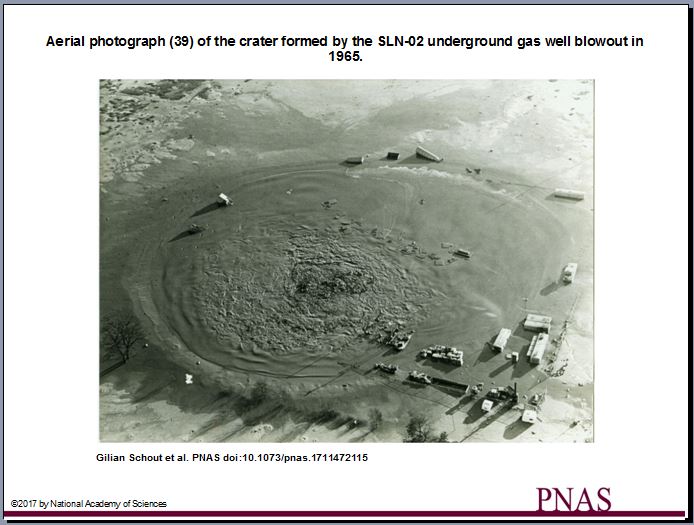FIFTY YEARS AFTER A BLOWOUT, THIS NATURAL-GAS RESERVOIR IS STILL CONTAMINATING THE LOCAL GROUNDWATER, A study of a blowout site in the Netherlands offers safety lessons for natural gas fields around the world by Francie Diep, January 2, 2018, Pacific Standard Magazine
Fifty years after a catastrophic blowout, an underground natural-gas reservoir in the Netherlands is still leaking methane into the local drinking-water aquifer, a new study finds. There’s no evidence of the methane leak above ground, but water drawn from some wells adjacent to the blowout site has enough methane in it to merit immediate action to prevent explosions, a team of Dutch geologists found.
The study adds to an ongoing debate about how often oil and gas drilling activity contaminates nearby aquifers. If you’ve seen that video of a homeowner turning on his kitchen tap and then lighting the stream on fire, that’s the effect of methane in the water. Oil and gas reserves are found much deeper in the Earth than reservoirs of well water, but scientists think that gas could migrate from the reserve to the aquifer if hydraulic fracturing—or fracking—wells are poorly made or develop cracks. A survey conducted this year found that about 2,700 active natural-gas storage wells across the United States may be at risk for leaks because they were built before certain safety techniques became widespread in the industry. (Methane may also appear in water from natural phenomena that aren’t related to oil and gas drilling.)
Methane dissolved in water isn’t known to be toxic when drunk, but if enough methane seeps from someone’s well or tap, it can asphyxiate people or—given a spark—explode.
The new study adds another scenario for regulators and citizens to consider: If a well has suffered a blowout, it may damage the reservoir in such a way that it continues to leak gases for decades. That’s exactly what a team of Dutch geologists found when they analyzed water wells around the site of a dramatic natural-gas well failure near the village of Sleen, in 1965. While workers were drilling a new well, it created unexpectedly high pressure underground. Several geysers of gas erupted around the field, which eventually coalesced into a 1,100-foot-wide crater that swallowed the drilling rig. Workers were not able to stop the leaks until more than two months later.
After the blowout, the local water company drilled several wells around the disaster site so that it could monitor the groundwater quality. The Dutch geologists took samples from these monitoring wells and analyzed them for methane, looking for chemical signatures that suggest where the methane came from: either the natural-gas reservoir, or from microbes that make methane when they decompose organic matter. Dutch groundwater sometimes has very high levels of methane naturally, the geologists write in their paper, so finding methane alone doesn’t mean the gas reservoir is at fault. But the scientists found high levels of reservoir-derived methane immediately around the blowout site, suggesting the reservoir is still leaking. Some of the concentrations they found were enough to merit immediate action, according to recommendations in a 2001 Department of the Interior report. Meanwhile, on the surface of the ground above the reservoir, there’s no evidence of any methane leaks, the Dutch geologists note.
In the U.S., just how often activities such fracking contaminate drinking water is up for debate. Several studies published in the journal Proceedings of the National Academy of Sciences—also home to the new study—have concluded that fracking frequently sends fossil-fuels gases into aquifers. But another recent study, published in the journal Environmental Science & Technology, found that water wells near fracking fields aren’t any more likely to have extra methane in them than wells far away from fracking operations. That study’s author told Science his results suggest well integrity problems are rare. As for gas fields that were subject to blowouts, people should monitor the water around them carefully, at several sites, the Dutch scientists write in their paper. There may be problems lurking underground, even if all seems well on the surface. [Emphasis added]
The study:
Impact of an historic underground gas well blowout on the current methane chemistry in a shallow groundwater system by Gilian Schouta, Niels Hartogb, S. Majid Hassanizadeh and Jasper Griffioen, December 18, 2017, PNAS
Abstract
Blowouts present a small but genuine risk when drilling into the deep subsurface and can have an immediate and significant impact on the surrounding environment. Nevertheless, studies that document their long-term impact are scarce. In 1965, a catastrophic underground blowout occurred during the drilling of a gas well in The Netherlands, which led to the uncontrolled release of large amounts of natural gas from the reservoir to the surface. In this study, the remaining impact on methane chemistry in the overlying aquifers was investigated. Methane concentrations higher than 10 mg/L (n = 12) were all found to have δ13C-CH4 values larger than −30‰, typical of a thermogenic origin. Both δ13C-CH4 and δD-CH4 correspond to the isotopic composition of the gas reservoir. Based on analysis of local groundwater flow conditions, this methane is not a remnant but most likely the result of ongoing leakage from the reservoir as a result of the blowout. Progressive enrichment of both δ13C-CH4 and δD-CH4 is observed with increasing distance and decreasing methane concentrations. The calculated isotopic fractionation factors of eC = 3 and eD = 54 suggest anaerobic methane oxidation is partly responsible for the observed decrease in concentrations. Elevated dissolved iron and manganese concentrations at the fringe of the methane plume show that oxidation is primarily mediated by the reduction of iron and manganese oxides. Combined, the data reveal the long-term impact that underground gas well blowouts may have on groundwater chemistry, as well as the important role of anaerobic oxidation in controlling the fate of dissolved methane.

